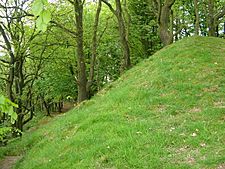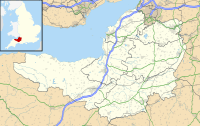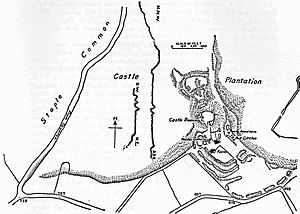Castle Neroche facts for kids
Quick facts for kids Castle Neroche |
|
|---|---|
| Near Staple Fitzpaine, Somerset, England | |

Eastern earthworks at Castle Neroche
|
|
| Coordinates | 50°56′13″N 3°02′15″W / 50.9370°N 3.0374°W |
| Type | Motte and bailey on Bronze Age site |
Castle Neroche is an old castle built by the Normans. It is a type of castle called a motte-and-bailey, which means it has a large mound (motte) and a walled courtyard (bailey). This castle was built on the site of an even older hill fort. It is located near Staple Fitzpaine in Somerset, England. Today, Castle Neroche is a Scheduled Ancient Monument. This means it is an important historical site protected by law.
Contents
Exploring Castle Neroche's Location
Castle Neroche sits on a hill that rises about 260 meters (850 feet) high. This hill is part of the northern edge of the Blackdown Hills. The area around the castle is part of a special project called the Neroche Scheme. This project covers about 35 square miles (90 square kilometers).
The Neroche Scheme helps create walking trails and public forests. It is led by the Forestry Commission. They get help from the Heritage Lottery Fund and local groups.
The Story of Castle Neroche
The name "Neroche" might come from old English words. These words, nierra and rechich, mean "the camp where hunting dogs were kept." This is why the castle is sometimes called Castle Rache.
Ancient Times: The Iron Age Fort
Long ago, people built large Iron Age hill forts. Historians used to wonder why these forts were built. Some thought they were for defense against invaders. Others believed they were built because more people meant less land for farming.
Today, many experts think that as iron became more common, society changed. Iron ore was found in different places than the metals used for bronze. This changed how people traded. It also meant that old leaders lost some of their power.
Archaeologist Barry Cunliffe believes more people led to tensions. He says forts offered places for communities to defend themselves. They were not always built because of war. But they were useful strongholds when problems arose.
There is not much evidence of Iron Age buildings at Castle Neroche. However, its location and shape are like other Iron Age sites. It seems the site was made stronger with an extra wall and outer area.
In 1903, a person named Harold St George Gray dug up parts of the site. Nearby, archaeologists found tools from the Mesolithic period. They also found a Bronze Age copper axe in 1857. But they found nothing from the Iron Age or Roman times.
The Normans and Their Castle
The earthworks at Castle Neroche are very large. They are bigger than what you would usually see at a Norman castle. This makes people think the Normans used parts of an older site.
The castle was likely built by Robert, Count of Mortain. He was an important Norman lord in the 11th century. Digging at the site shows it was built in different steps. First, a large wall was built around 7.5 acres (3 hectares).
Soon after the Norman Conquest, a smaller inner fort was added. Later, the site became a motte and bailey castle. The motte, a mound about 20 feet (6 meters) high, had a corner that acted like a barbican. A barbican is a fortified gatehouse.
By the early 1100s, the castle was not used much. But it was used again during a time of civil war in England. This period was called The Anarchy. It was a fight over who should be king. Later in the 1100s, the castle might have been used by people who managed the nearby royal forest. They used it to stop poachers, who were people illegally hunting animals.
A Sad Event: Air Disaster
On November 22, 1945, a Royal Air Force plane crashed near the castle. It was a Consolidated B-24 Liberator aircraft. The plane hit trees on the Blackdown Hills. Sadly, all 27 people on board died in the crash.
Images for kids




